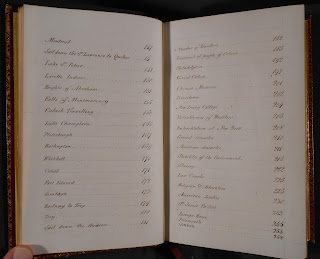I've been eyeing this box for quite some time. It's in our "Illustrated" collection, so I wondered if there were racy images that had to be locked up (I mean, we just did a class using some of our uncatalogued erotica). But no. After struggling with the latches, I was greeted by a serene title page: Canadian Scenery Illustrated, from Drawings by W. H. Bartlett. Not quite what I was expecting, but still cool!

The box contains a series of magazines published in London in 1842 concerning Canada. During this period, Canada was under British rule. Canadian Scenery becomes a participant in the project of British imperialism, bringing "human interest" scenes of Canada to London homes, from descriptions of Native American life to engravings of Montreal.
 The author, Nathaniel Parker Wills (Esq.), also wrote "Pencillings by the Way" and "Inklings of Adventure," two titles with a bit more punch than Canadian Scenery Illustrated. He was one of the highest-paid magazine writers of his day and established the Home Journal, which would eventually become Town and Country. We have a lot of other items in our collection by Wills, including a play titled Bianca Visconti; or, the Heart Overtasked and Hurry-graphs; or, Sketches of scenery, celebrities and society, taken from life.
The author, Nathaniel Parker Wills (Esq.), also wrote "Pencillings by the Way" and "Inklings of Adventure," two titles with a bit more punch than Canadian Scenery Illustrated. He was one of the highest-paid magazine writers of his day and established the Home Journal, which would eventually become Town and Country. We have a lot of other items in our collection by Wills, including a play titled Bianca Visconti; or, the Heart Overtasked and Hurry-graphs; or, Sketches of scenery, celebrities and society, taken from life. But, as in almost all nineteenth-century serials, the most comic part is the advertisements. My favorite advertises an edition of The Works of Shakespere [sic], which includes "the Attributed Plays" -- Locrine, Sir John Oldcastle, Thomas Lord Cromwell, The London Prodigal, The Puritan, and Yorkshire Tragedy. I've never even heard of any of these plays, but it turns out we have several copies of those plays, too -- a future blog entry?!
Ask for Illus B258c to learn more about nineteenth-century Canada.


